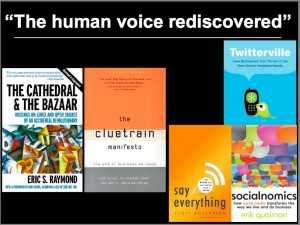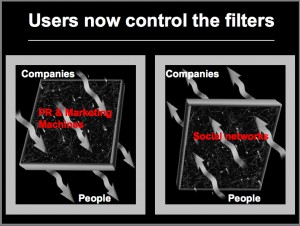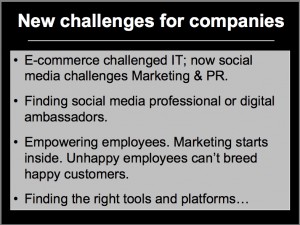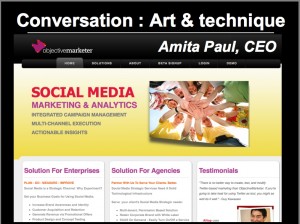 Earlier this week, I had the privilege of delivering an introductory speech for a great product, ObjectiveMarketer, in front of remarkable executives and CIOs from the European Institutions hosted by Cisco Systems. It’s always a challenge to speak to an extraordinarily knowledgeable audience that is well versed in both technologies and trends, but it is also a rewarding experience. Below is a summary of my presentation.
Earlier this week, I had the privilege of delivering an introductory speech for a great product, ObjectiveMarketer, in front of remarkable executives and CIOs from the European Institutions hosted by Cisco Systems. It’s always a challenge to speak to an extraordinarily knowledgeable audience that is well versed in both technologies and trends, but it is also a rewarding experience. Below is a summary of my presentation.
I focused on the fact that social media are the very essence of the Internet, and in many ways, its revenge. The expression “Social Media” was coined by Chris Shipley fairly recently, in 2004 (BlogOn 2004), when she announced a conference designed to explore the rising business opportunities in blogging and social networking to be held in July at Berkeley’s Haas Business School. Blogging that had started in the mid-1990’s was blooming left and right, and social networks were becoming the talk of the town. Friendster and Meetup had been created in 2002, MySpace, Linkedin, Rize, and many others in 2003, and Facebook (albeit still unknown) was to receive its first investment of US$500,000 from Peter Thiel, the co-founder of Paypal (June 2004). As we all know, since that time, the number of social networks has increased considerably. There are hundreds of them. The short list of the major ones provided by Wikipedia includes about 160 sites. When you add up the number of members of the seven biggest social networks, you easily pass the one billion users. The number of social networks users is way higher than the number of Internet users (approximately 1.67 billion people worldwide), which is not surprising as each individual can have several social network personas.
 While such massive emergence of social networks comes right after the dotcom bust, it’s by no means a comparable phenomenon. It’s the expression of what Internet was from day one, a place where people wanted to express themselves whose voices were somewhat hijacked by the dotcom hysteria — and only waiting to break loose. In short, social media as we know them today are the revenge of the Internet.
While such massive emergence of social networks comes right after the dotcom bust, it’s by no means a comparable phenomenon. It’s the expression of what Internet was from day one, a place where people wanted to express themselves whose voices were somewhat hijacked by the dotcom hysteria — and only waiting to break loose. In short, social media as we know them today are the revenge of the Internet.
Social networking was the raison d’être of the Internet – and actually predated it. In the early eighties, multiple efforts to optimize the interconnection of computer networks (initially started by RAND Corporation in the fifties to facilitate cooperation between its research teams in Pennsylvania and California) came to fruition, and the need to unify communication protocols led to the adoption of TCP/IP in 1982 — along with the definition of the word “Internet.” However, Internet or not, technology-enabled interconnections of geographically dispersed people had already started to expand beyond research organizations, reaching sundry university groups. The first real structured social networks appeared with the first NewsGroups: Usenet was conceived in 1979 by two students from Duke University. Discussion groups multiplied: in 1981, Ira Fuchs created BITNET (acronym of “Because It’s Time Network”) for liberal arts professors, and by 1984, it was connecting over 150 campuses. In 1986, Eric Thomas, then a student at l’Ecole centrale de Paris, invented LISTSERV, an automated mailing list manager that enabled users to join a list without the need for human administration; this introduced the concept of a list owner.
Throughout the eighties, services proliferated. User forums sprang left and right on CompuServe, and in the course of the nineties, everybody progressively adopted the Word Wide Web, a system of interlinked documents using TCP/IP, that Tim Berners-Lee and Roger Cailliau had set up in 1989/1990 to enable researchers at the CERN to share information. The increase of Internet users expanded and modernized the concept of NewsGroups. That’s the key to the success of companies such as eGroups, started in 1997: eGroups had 18 millions users when they were acquired by Yahoo! in August 2000 and integrated within Yahoo! Groups — itself launched in 1998. The eGroups phenomenon prefaced the explosion of social networks that we know today. The Internet is “the human voice rediscovered,” as The Cluetrain Manifesto: The End of Business as Usual summarized ten years ago. The renewed interest in Social Media is the opportunity to re-read another important book, The Cathedral & the Bazaar: Musings on Linux and Open Source by an Accidental Revolutionary where Eric Raymond expanded on his remarks at the Linux Kongress in Würzburg in 1997. These two books are echoed and updated in multiple interesting recent books, such as Say Everything: How Blogging Began, What It’s Becoming, and Why It Matters, Twitterville: How Businesses Can Thrive in the New Global Neighborhoods, and Socialnomics: How social media transforms the way we live and do business (1).
 Social media are not a fad. Nobody will ever stop billions of voices. The July 2009 Ruder Finn Intent Index (1) provides interesting statistics: 76% of Internet users go online to discuss. When, on the other hand, you see that 78% of consumers trust peer recommendations and that only 14% trust advertisements, it’s clear that we have entered an era that will mandate a radical transformation of the way companies do business. While the majority of companies still cling to a top-down communication model with their potential customers, consumers trust the opinion of their extended families, their networks. Therefore companies now have to start learning how to reach the heart and mind of an increasingly hard-to-categorize “consumer,” an individual whose identity is spread across multiple personas. The rules are changing. We are quickly moving away from a world where access to companies by people is filtered by marketing departments and PR, to a world where this access is filtered by social networks. As a result, companies face serious challenges.
Social media are not a fad. Nobody will ever stop billions of voices. The July 2009 Ruder Finn Intent Index (1) provides interesting statistics: 76% of Internet users go online to discuss. When, on the other hand, you see that 78% of consumers trust peer recommendations and that only 14% trust advertisements, it’s clear that we have entered an era that will mandate a radical transformation of the way companies do business. While the majority of companies still cling to a top-down communication model with their potential customers, consumers trust the opinion of their extended families, their networks. Therefore companies now have to start learning how to reach the heart and mind of an increasingly hard-to-categorize “consumer,” an individual whose identity is spread across multiple personas. The rules are changing. We are quickly moving away from a world where access to companies by people is filtered by marketing departments and PR, to a world where this access is filtered by social networks. As a result, companies face serious challenges.
 Twelve years ago IT departments didn’t want to hear about transactional websites. Therefore, e-commerce ended up in the lap of marketing departments. Today, social networks challenge marketers. They have to find qualified social media professionals to help out, which may not be easy when departments are stuck with antiquated criteria. They may hire consultants, but even the best consultants on the planet will have limited impact if corporate habits don’t change at the same time: the reality is that social media mandates that it becomes part of the company’s culture to empower and trust employees (how could unhappy employees safely converse with customers?). Marketing must start inside; every employee must turn into a potential evangelist. This may give a few headaches to traditional marketers, but the example of a few forward-thinking companies shows that the current trend is irreversible.
Twelve years ago IT departments didn’t want to hear about transactional websites. Therefore, e-commerce ended up in the lap of marketing departments. Today, social networks challenge marketers. They have to find qualified social media professionals to help out, which may not be easy when departments are stuck with antiquated criteria. They may hire consultants, but even the best consultants on the planet will have limited impact if corporate habits don’t change at the same time: the reality is that social media mandates that it becomes part of the company’s culture to empower and trust employees (how could unhappy employees safely converse with customers?). Marketing must start inside; every employee must turn into a potential evangelist. This may give a few headaches to traditional marketers, but the example of a few forward-thinking companies shows that the current trend is irreversible.
 To scale their efforts, these companies need novel supportive technologies. Currently, numerous personal productivity tools are available. We are starting to see a few enterprise products capable of “listening to” customers. Yet, what is also critically needed is the ability to structure the way to talk to customers, as well as to measure the relevancy and the impact of the way you address them. This is precisely what ObjectiveMarketer, founded by Amita Paul, was designed to do. I am happy to work with her as an advisor — along with a friend of mine, Guy Kawasaki, co-founder of the most extraordinary online magazine rack, Alltop. Amita presented ObjectiveMarketer and I can only encourage you to try this remarkable product! (3)
To scale their efforts, these companies need novel supportive technologies. Currently, numerous personal productivity tools are available. We are starting to see a few enterprise products capable of “listening to” customers. Yet, what is also critically needed is the ability to structure the way to talk to customers, as well as to measure the relevancy and the impact of the way you address them. This is precisely what ObjectiveMarketer, founded by Amita Paul, was designed to do. I am happy to work with her as an advisor — along with a friend of mine, Guy Kawasaki, co-founder of the most extraordinary online magazine rack, Alltop. Amita presented ObjectiveMarketer and I can only encourage you to try this remarkable product! (3)
Marylene Delbourg-Delphis
(1) Say Everything: How Blogging Began, What It’s Becoming, and Why It Mattersby Scott Rosenberg, Twitterville: How Businesses Can Thrive in the New Global Neighborhoods,by Shel Israel and Socialnomics: How social media transforms the way we live and do busines by Erik Qualman are three books that I discussed in earlier posts.
(2) http://www.ruderfinn.com/rfrelate/intent/intent-index.html
(3) More about ObjectiveMarketer. The product will be presented at BlogWorld on the Alltop booth (October 15-17, http://www.blogworldexpo.com)

2 responses so far ↓
1 Twitter Trackbacks for Social Media: The Revenge of the Internet [delbourg-delphis.com] on Topsy.com // Oct 9, 2009 at 12:27 pm
[…] Social Media: The Revenge of the Internet delbourg-delphis.com/2009/10/social-media-the-revenge-of-the-internet – view page – cached ← Guest-speaking in Bob Lowry’s class at UMass Amherst: Entrepreneurs are — From the page […]
2 Shava Nerad // Oct 9, 2009 at 1:21 pm
Beautiful, cogent, and terse history! I’ve been working online since 1982, and it’s been a journey, but USENET (newsgroups system mentioned) was my first love. I was in net.women, which included perhaps half of the women engineers online at the time.
It’s all one story.
I still want a t-shirt in VT-100 font that says, “USENET was my blog!”
Leave a Comment